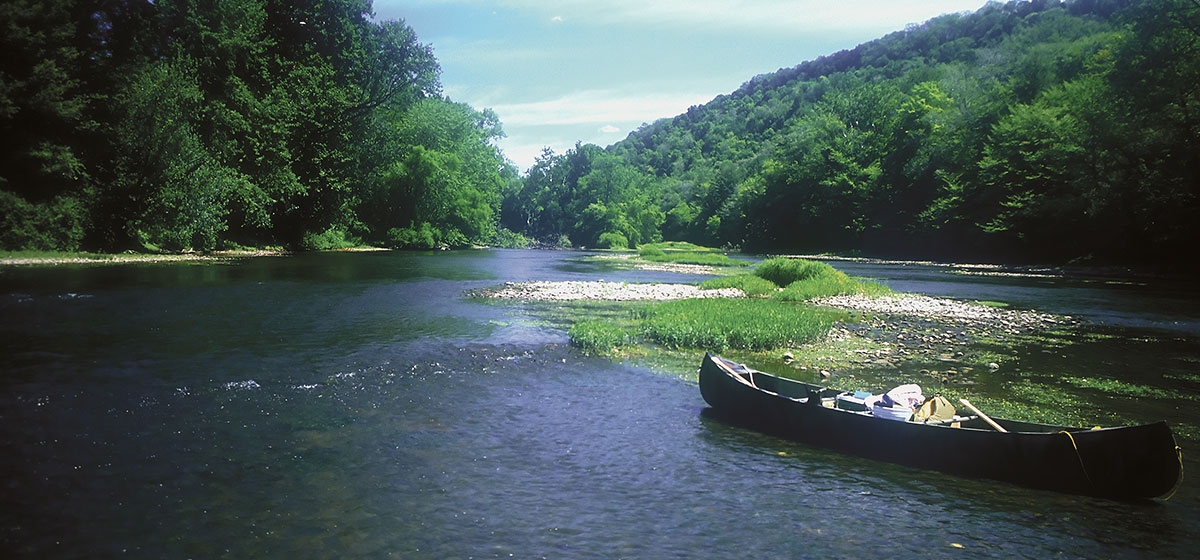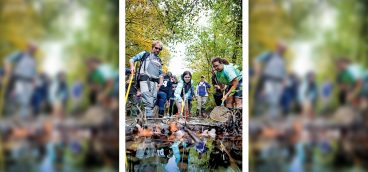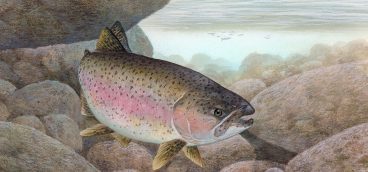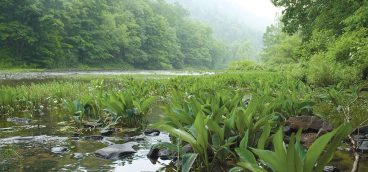A Rhapsody in Blue

This summer, as Pittsburgh hosts World Environment Day and the world focuses on biodiversity, a small river 90 miles north of the city will do what it has always done. Quietly, its waters wind along a 117-mile path from Chautauqua County, New York, into western Pennsylvania, where it joins the Allegheny River at Franklin.
And under that water and along its edges, a rare and pristine ecosystem will sustain scores of animals that are endangered across the globe.
Designated one of the “Last Great Places in America” by The Nature Conservancy, French Creek received its name in 1753 when a young British officer investigated French positions in the wild area. And the watershed has remained largely as untarnished as it was when that officer, George Washington, canoed it, one of the few waterways in the northeastern U. S. to retain its pre-colonial eco-system. The tree-lined creek is home to 89 species of fish and 27 species of freshwater mussels. “French Creek with its vibrant, abundant life has the best population of some aquatic systems on earth,” said Charles W. Bier, senior director of conservation Science of the Western Pennsylvania Conservancy, who has studied French Creek for over 20 years. Bier cited a 1998 nationwide study that reviewed aquatic biodiversity and noted the blighted popu-lations of many species. “It also listed the most important streams to protect. That short list includes French Creek.” The creek, however, hasn’t retained its health through happenstance. Many organizations have donated time and money to restore and preserve this watershed. Two Pittsburgh giants, the Richard King Mellon Foundation and the Heinz Endowments, have led a decades-long preservation effort.
French Creek’s significance is two-fold, according to Caren Glotfelty, director of The Heinz Endowments’ Environment Program. “First, its headwaters and tributaries drain into the Allegheny River, and second, it’s home to the highest aquatic diversity maybe in the mid-Atlantic region.” “Creek” is really a misnomer, brining to mind a pencil-thin line, whereas French Creek is a wide, rushing water-way. The riffle, or fast-flowing sections, keep it fairly free of invasive species such as zebra mussels or Asian carp; both prefer quieter waters. For 20 years Phil Ness, an Allegheny College development officer and former basketball coach, has fished French Creek. In summer he does it from a canoe floating from Saegertown to Meadville or from Cochranton to Utica. He casts for walleye or muskie and fly fishes for smallmouth bass. Almost always, he releases what he catch-es. “It’s not that I don’t trust the creek, it’s just so fun to catch the fish that I want to keep them there for generations.”
Time has been on the creek’s side. Some 15,000 years ago, the Wisconsin glacier altered its northern course into Lake Erie, sending it southward. That glacial action dragged the lake across two watersheds, contributing to the creek’s famed aquatic diversity. The glaciers also scooped up limestone from Canada, depositing a thick layer that coats the landscape like icing on a cake. Limestone’s alkaline nature neutralizes acid rain and other pollutants that blow in from the Ohio River Valley, making the creek that much more resilient.
It also fosters mussels’ shell production.Not all mussels are just a slab of muscle caught between two shells. Some have evolved remarkable life-cycle strategies. Many mussels treat reproduction casually, with females casting eggs into the water and males spraying sperm haphazardly. In some species, however, the female takes extraordinary steps. She keeps her eggs inside where they are also fertilized. Then she crafts a lure out of her own living tissue. Inside this packet, she inserts the fertilized eggs and then wriggles it about so a fish will nip at it. The lure attaches to the fish, from which the larvae draw nutrients. When the mussel larvae have morphed to their junior stage, they drop off, sink down and settle among the rocks.
The presence of mussels, hellbenders and darter fish signify the creek’s water quality. True to its name, the darter fish is a tiny—1 to 2 inches long—colorful fish that darts about. Fifteen varieties, including the endangered spotted darter, the bluebreast darter and the sand darter, are native to these waters.
The rare hellbender, a pre-historic-looking salamander that grows up to 2 1/2 feet long, slides along the stream bed. Others lurk beneath flat-faced rocks feeding on crayfish. “Many salamander species that had been around for at least 30 million years have vanished from 60 percent of their original range in Pennsylvania,” said Wendy Kedzierski, educational director of Creek Connection, a program that educates regional students about the value of French Creek. Clinging to the rocks beneath the surface of the green-tinted water are the most fragile of French Creek’s residents—hordes of mussels. French Creek is rich in mussels, including the endangered Northern riffleshell mussel and the clubshell mussel which has disappeared from 95 percent of its former habitat.
“Freshwater mussels actually represent the most impacted wildlife on Earth,” said Bier, noting that 71 species of mussels are on the U.S. list of endangered species. “Mussels have been known to live 100 years; the shortest-lived mussels we have are a couple of decades old,” said Darran Crabtree, a freshwater scientist for The Nature Conservancy. A shell on his desk has 70 ridges, one for each year of its life. These tough bivalves draw water through their bodies to breathe and eat, thus making them vulnerable to any pollutants floating by. And their basic actions also filter the water for us.
“A drop of water starting in French Creek’s headwaters on average will go through the gut of one mussel before it enters the Allegheny River,” said Crabtree, noting that the Allegheny supplies Pittsburgh’s drinking water.
“The absence of economic development is one reason this creek has stayed relatively natural,” said The Heinz Endowments’ Glotfelty. French Creek runs through rural Pennsylvania counties that are mostly free of heavy industry. The stream bank is also protected by miles of forest and riparian buffer zones. These act to cool the water and nourish it, and protect creek banks from erosion and road runoff. People and their actions, however, have an impact.
“The primary threat to the creek is not from industry, it’s from non-point source water pollution, runoff from parking lots, roads, lawns and farm fields,” said Brian Hill, former director of the French Creek Project, an awareness-building program of the Pennsylvania Environmental Council. “Efforts to protect the stream require engaging the community, because their everyday decisions and behavior determine if it will thrive or perish.”
A host of environmental agencies protect the stream, and dollars have poured in from organizations such as the Western Pennsylvania Conservancy, which purchased its first property abutting the creek in 1969. Since 2007, the Conservancy has invested $850,000 in research, land acquisition, watershed conservation and staff time.
Raising awareness about the treasure running through residents’ back yards has been a key piece of the conservation puzzle. Farmers, for example, are encouraged to use best management practices, such as keeping their livestock out of the stream, not planting up to the stream’s edge, and keeping fertilizers and pesticides from draining into the water.
The Pennsylvania Council on the Environment has also suggested storm-water management practices for municipalities to prevent heavy rains from washing road salt, oil and fertilizer into the creek and to keep flash floods from eroding its banks.
The Nature Conservancy, Western Pennsylvania Conservancy and the French Creek Valley Conservancy work together to identify the watershed’s most critical parcels, and the groups advocate conservation easements, which leave land in private hands but limit development.
As a result of the efforts, public regard for the creek is increasing. Each year, the French Creek Valley Conservancy hosts a creek cleanup, with canoeing volunteers pulling out trash in an overall effort that netted over 10,000 pounds of trash last year, including car tires and shopping carts. The creek’s length and ease of access makes it an easy dumping ground. But it’s also easy to slip a canoe or kayak into it. “When you’re on the water, you feel like you’re alone in the woods,” said Creek Connection’s Kedzierski.
Jim Lang, vice president of the French Creek Valley Conservancy, agreed. “What’s great is that you can throw a canoe in your truck and in 15 minutes put it in the creek and be floating along with no cell phones, while bald eagles, hawks and osprey fly overhead. And you don’t have to pay anybody anything to do it.”




